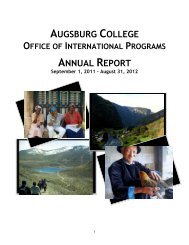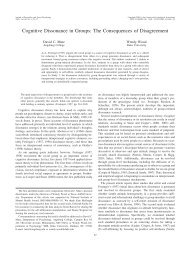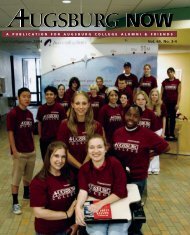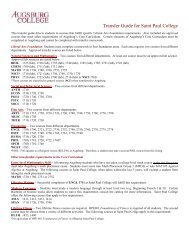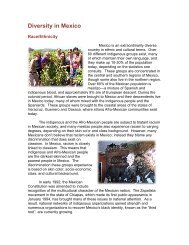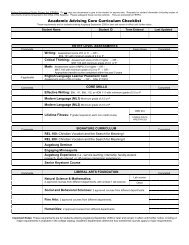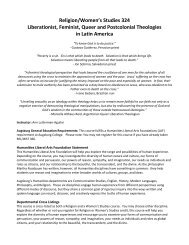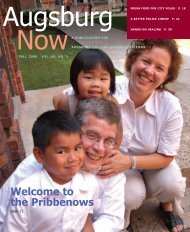UnderstandinghealthcareR E F O R MBY BETSEY NORGARDDemystifying the new healthcare legislation was the focus of the Sabo Center Public Policy Symposium on October 15.Panelists were (L to R) Martin Sabo ’59, moderator; Donna Zimmerman, HealthPartners; Dr. Sanne Magnan, MinnesotaDepartment of Health; and Dr. Bruce Amundson ’60, Community Health Innovations, Inc.On March 23, 2010, President Obamasigned into law the Patient Protection andAf<strong>for</strong>dable Care Act. It’s complex, difficult-to-understandlegislation and is theproduct of an extremely contentiouspolitical process.On October 15, at its fifth public policy<strong>for</strong>um, <strong>Augsburg</strong>’s Sabo Center <strong>for</strong> Citizenshipand Learning hosted a <strong>for</strong>um to decodeand discuss the challenges and opportunities<strong>this</strong> legislation presents <strong>for</strong> Minnesotaand the nation—that is, how the currenthealthcare system will change. The symposiumwas moderated by retired U.S. Rep.Martin Sabo and presented speakers whoare leaders in the healthcare field.Donna Zimmerman, senior vice presidentof government and community relationsat HealthPartners in Minneapolis,addressed the overall scope of the law andfocused on the impact of provisions concerningchanges to insurance coverage.“It is a major task to think about howto explain <strong>this</strong> major piece of legacy legislationour Congress has passed,” Zimmermansaid. “I’ll try to demystify <strong>this</strong> bigbill, and focus on what’s important <strong>for</strong> usin Minnesota.”Her presentation explained variousprovisions of the act that have alreadytaken effect or are being phased inshortly; <strong>for</strong> example, extension of benefitsto dependent children up to age 26,adding <strong>more</strong> preventive care without costsharingby consumers, and prohibition oninsurance denial to children under age 19<strong>for</strong> pre-existing conditions.Dr. Sanne Magnan, commissioner of theMinnesota Department of Health, spokeabout changes to health care itself and theinterface with Vision Minnesota, Minnesota’sre<strong>for</strong>m passed in 2008. Her messagewas that the federal re<strong>for</strong>ms will nothave as radical an effect in Minnesota as insome states because Minnesota’s qualityand delivery of health care are already consistentlyhigher than in many states.She spoke about how Minnesota is coordinatingwith federal initiatives to influencehow health re<strong>for</strong>m is implemented, “so thatwe can build on the innovative strategiesMinnesota has been doing as well as learnfrom other states who have been doinghealth re<strong>for</strong>m.”She compared provisions <strong>for</strong> re<strong>for</strong>m inthe new federal law with similar provisionsin Vision Minnesota and showed how anumber of them are already being implementedin <strong>this</strong> state.Magnan also explained that much of thedifficulty in enacting re<strong>for</strong>m stems from howthe current healthcare system was set up.The incentives and payments <strong>for</strong> health careare made to doctors and providers <strong>for</strong> treatmentof illness, and not <strong>for</strong> promotion andmaintenance of health. Payment is made <strong>for</strong>office visits, hospitalization, tests, procedures,and drugs, rather than <strong>for</strong> bettermanagement of chronic disease, prevention,and promotion of wellness.Dr. Bruce Amundson ’60, president ofCommunity Health Innovators, Inc. and assistantprofessor at the University of WashingtonSchool of Medicine, spoke about hislongtime work to seek re<strong>for</strong>m in the healthcaredelivery system to provide everyonewith easy access to a team of healthcareprofessionals who can provide comprehensivecare at lower costs.Amundson offered a vision of the optimalhealthcare model (see next page) thatfocuses on a team approach to ongoing, primarycare in clinics, which includes clinicalcare as well as services in other areas thataffect health. These clinics or “medicalhomes” must then be part of, or connectedto, a system that includes specialty-careand hospital and emergency services.Sabo Center Public Policy Symposium2010 Healthcare Re<strong>for</strong>m:What Will It Mean <strong>for</strong> You (and the Nation)?October 15, 2010Panel Participants:DONNA ZIMMERMAN, Senior Vice President ofGovernment and Community Relations,HealthPartnersDR. SANNE MAGNAN, Commissioner, MinnesotaDepartment of HealthDR. BRUCE AMUNDSON ’60, President, CommunityHealth Innovations, Inc., and AssistantProfessor, University of Washington School ofMedicineEALTHCARE22 <strong>Augsburg</strong> NowMARTIN SABO ’59, Moderator; U.S. House ofRepresentatives, 1978–2006To see the slides from these presentations andview the video of the symposium, go towww.augsburg.edu/now
BY DR. BRUCE AMUNDSON ’60What is ideal healthcare delivery?The recent health re<strong>for</strong>mlegislation primarilyfocuses onhelping <strong>more</strong> peopleget health insuranceand on addressingsome insurance injustices.It does notsystematically addressdelivery system re<strong>for</strong>m—how you receivehealth care—but elements of the actdo support ongoing re<strong>for</strong>m ef<strong>for</strong>ts. To understand<strong>this</strong>, you must have a clearer picture ofwhat clinical and healthcare leaders see as a“re<strong>for</strong>med delivery system” and what wehave been working towards—<strong>for</strong> years.Within the past few years a growingagreement has emerged on what an optimaldelivery system should look like, both to beable to provide excellent and comprehensivecare and to reduce costs. These are the keyelements:First, your health care must be anchoredby primary care clinicians—physicians(family practice, general internalmedicine, pediatricians), nurse practitioners,and physician assistants. This ensuresthat you have a personal ongoing relationshipwith a clinician who is the “generalcontractor” <strong>for</strong> your health issues and whois your trusted partner.Second, you should be part of a clinicor system that provides a “medical home”with your primary clinician. Your medicalhome must serve as the first stop <strong>for</strong> ANYhealth issues that arise, short of criticalemergencies.Further, your medical home should have:• An electronic health record to ensure immediateaccess to your history <strong>for</strong> all whotreat you wherever they are located• More convenient access to your clinicians—same-dayappointments, expandedhours, e-mail to your clinicians• Management of all referrals to specialistsand other services you may need, ensuringcoordination and avoiding duplication• Systematic management of commonchronic diseases• Case management <strong>for</strong> people with complexand/or multiple health issues includingmonitoring of prescription drugs• Healthcare teams to expand clinical competencyand servicesThe emergence of primary care teams is oneof the most important developments in recentyears. I would describe the “optimal primarycare team” as comprised of:• Primary care clinicians (physicians, nursepractitioners, physician assistants)• Mental health clinician• Social worker with family therapy skills• Nurse case manager <strong>for</strong> patients withcomplex conditions• Chronic disease care nurse• Patient educator• Pharmacist• Physical therapist or massage therapistResearch has shown that with <strong>this</strong> range ofskills a clinic or medical home can competentlyhandle 80% or <strong>more</strong> of the healthproblems that it receives. It can care <strong>for</strong>the whole person and meet total needs.This is a radical change, but examples of<strong>this</strong> model now exist across the country.The third component is that every clinicor medical home must be part of an organizedsystem of care that includes most specialtyphysicians, hospital and ER services,and other important services. If not withinthe same organization, at least there must be<strong>for</strong>mal ties and relationships between themedical home and these other elements of acomprehensive healthcare system.Because our human condition is complex,people are affected by physical issues,mental health problems, family dysfunction,substance abuse, environmental exposures—and often a combination or all of the above.Clinical care is, there<strong>for</strong>e, also very complexif it is going to be relevant to the person’sneeds and holistic in its aims. The combinationof knowledge and skills represented inthe optimal team described above brings thehealthcare delivery system closer in alignmentwith human needs, with the foundationbeing “relationship-based” (versus “diseaseoriented”)care.The re<strong>for</strong>m legislation recognizes thework by clinicians and leaders in definingwhat we seek as health re<strong>for</strong>m goals. While itdoes not fundamentally change the currenthealthcare delivery system, it supports clinician-ledre<strong>for</strong>m by:• Recognizing the role of primary care cliniciansand increasing financial support <strong>for</strong>training them• Providing bonus payments <strong>for</strong> care managementof Medicare and Medicaid enrolleeswhen needed• Providing financial incentives <strong>for</strong> establishingorganized systems of care• Expanding wellness and preventive coveragein insurance plans• Funding research on the clinical effectivenessof various treatments• Creating a Center of InnovationThe legislation is not radical. It builds onour current private insurance and deliverysystems. It may not be able to address costissues, but it does represent a huge steptoward ensuring universal insurance coverageand a <strong>more</strong> effective delivery system. Italso must be seen as a move to narrow thegap between healthcare “haves” and “havenots.”While there’s an immense amount ofwork ahead, it’s critical to understand that<strong>for</strong> clinicians and most healthcare leaders,there is no turning back. The whiff of somethingbetter, a humanizing system, is in theair and a national re<strong>for</strong>m process is underway.I could not be <strong>more</strong> hopeful.Dr. Bruce Amundson ’60 is president ofCommunity Health Innovations, Inc. inShoreline, Wash.Fall 201023



